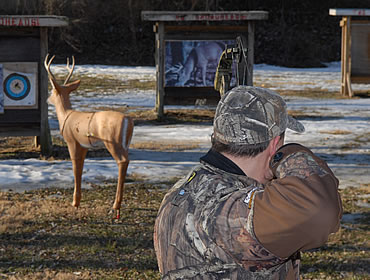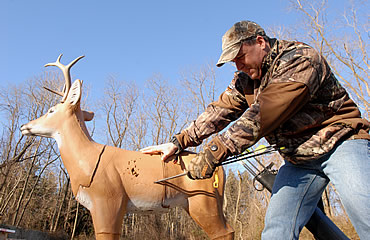By P.J. Reilly
How often does a buck show up at exactly 20, 30 or 40 yards?
In a perfect world, all bucks would carry BTR racks. They’d never see, hear or smell us, and they’d all show up in daylight and stop broadside in clear shooting lanes at exactly 20, 30 or 40 yards.
Unfortunately, this isn’t a perfect world, and bucks, especially mature ones, rarely do what we want.
Get used to it. That’s never going to change.
The best you can hope for when a big buck shows up is that you are prepared to close the deal and zip an arrow straight through his boiler room.
Most bowhunters with multi-pin sights on their bows set their pins for round, even distances, such as 20, 30, 40 and 50 yards. Learning to shoot the gap — putting an arrow on target at ranges that fall between your sight pins — is crucial for success in the deer woods.
A big buck is far more likely to show up at a distance that doesn’t end in zero. If you have a four-pin sight with pins set for 20, 30, 40 and 50 yards, there are only four distances from 0 to 50 yards for which your pins are precisely calibrated. There are 46 whole-yard distances for which your pins aren’t set. You don’t have to be a Las Vegas bookie to know that 46 out of 50 are better odds than four out of 50.
So, if you want to boost your chances of punching a buck tag during bow season, be sure you’re just as accurate shooting at 33 yards as you are at 30. To be certain of that, you must master the art of shooting the gap.
PIN GAP
The space between your sight pins is called pin gap. An arrow leaves a bow and flies with a downward-arcing trajectory. The farther the arrow travels, the more it slows and the sharper it arcs toward the ground. Consequently, your sight pins are set to follow that arc and mark different spots along the arrow’s flight path so you know where it’s going to hit a target at different distances.
There is a never-ending debate about just how important arrow speed is in the game of bowhunting, but there’s no question about its impact on pin gap. The faster your bow shoots, the smaller your pin gap will be.
For example, if my arrow’s speed is 300 feet per second (fps), my pin gap between 20 and 30 yards is going to be very small. That’s because my arrow is flying so fast it doesn’t drop much between those two distances.
At 200 fps, the gap is going to be bigger to compensate for the sharper arc in the arrow’s flight path. So, at 300 fps, I will still hit the vitals with my 20-yard pin on a deer that’s 25 yards out.
Shooting an arrow moving 200 fps, my 20-yard pin will hit below the vital area on a buck at 25 yards. Further, if I switch to my 30-yard pin, I’ll hit the backbone or shoot over that same buck.
 Shooting the 200-fps arrow, I must compensate for the slower speed and increased arc in the arrow’s flight path by raising my 20-yard-pin above the bullseye. Since I don’t have a pin set for 25 yards, I have to aim using my 20- or 30-yard pin, using it as a reference point, instead of holding it on the bullseye.
Shooting the 200-fps arrow, I must compensate for the slower speed and increased arc in the arrow’s flight path by raising my 20-yard-pin above the bullseye. Since I don’t have a pin set for 25 yards, I have to aim using my 20- or 30-yard pin, using it as a reference point, instead of holding it on the bullseye.
When you set pins for 20, 30, 40 and 50 yards, you’ll probably notice the gaps widen slightly as the distances increase.
That seemingly miniscule widening of the gap is a bit of an optical illusion, because targets shrink in perspective as you move farther away. Although the physical gap between pins increases by only micro-fractions of an inch, they account for much steeper arcs in your arrow’s trajectory. That becomes a factor in range determination.
RANGE DETERMINATION
The first step in figuring out how to aim in the gap is determining the distance to the target. If you have a laser rangefinder, that’s as simple as pushing a button. If you don’t, or a buck shows up so fast you don’t have time to use it, you’re going to have to estimate the yardage. Many hours on the practice range will hone that skill.
Because of the increasing arc in arrow trajectory as the distance to your target grows, your range estimation has to get more precise the farther out you shoot. A 300-fps arrow shot on level ground at a 25-yard target using your 20-yard pin will probably hit only an inch or so below where you aimed. But if you use your 40-yard pin on a target that’s 45 yards out, the arrow could hit a foot or more low, depending on your arrow’s speed. At 40 yards, you need to correctly guess the distance within a yard or two to keep your arrow in a deer’s vitals.
Also, if you’re shooting from a treestand, you’ll have to account for downward angle. Generally, shots from treestands arc less than those on flat ground. That is, an arrow shot from a treestand at a 20-yard target is likely to strike higher than it would on level ground, assuming your 20-yard pin was set while shooting on level ground. So, when shooting from a stand, you would need to hold your 20-yard pin low of where you want your arrow to hit.
Again, speed plays a part, so the best way to determine where your arrow hits from a treestand is to practice from an elevated position.
 HIGH OR LOW?
HIGH OR LOW?
When you begin practicing shooting the gap, you’ll probably start to favor one of the pins that frame the gap. You’re going to have an upper pin and a lower one setting the boundaries for every gap. You might feel more comfortable holding your top pin high on a target, or you might prefer holding the lower pin underneath the spot you want to hit. Don’t fight whatever feels natural. The truth is, it doesn’t matter which pin you use.
I use both pins when shooting the gap. Since my pins are set at 10-yard increments, I divide every gap in half. If my target is 1 to 5 yards farther than the distance the pin at the top of the gap is set for, I hold the top pin high. If my target is 6 to 9 yards farther than the distance the pin at the top of the gap is set for, I hold the bottom pin below the spot.
How high or low I hold depends on the exact distance. Every bow performs differently. You have to figure out the formula that works for you.
LEFT-RIGHT
Bowhunters who use sights with vertically stacked pins, like the Trophy Ridge Alpha V3 and V5 don’t have to worry about drifting off center because the black line formed by the posts of the pins creates a perfect anchor. That line helps maintain left-right shot placement when shooting the gap because it’s a physical mark you can place on the bullseye.
Without a point of reference to keep you from drifting, however, maintaining perfect left-right shot placement can be difficult.
It’s common for the bow to drift left or right as your mind struggles with judging distance and hitting a target without a pin on the actual bullseye.
One way to help maintain left-right accuracy is to get a sight that has a thin wire running top to bottom through the sight window. Such a wire in my Spot Hogg Hogg-It sight allows me to keep centered whenever I’m shooting a gap.
If you don’t use a sight with a vertical alignment wire, you can always try bracketing. While settling on the target, check the pin you’re not focused on to make sure the exact spot you want to hit is directly above your lower pin and directly below your top pin.
GET USED TO IT
Repetitive shooting teaches muscle memory and allows your body to perform on autopilot when your heart is thumping and adrenaline is flooding your veins as you draw back on a monster buck. It also teaches your brain to recognize what targets should look like at different distances. Shoot over and over again at distances between your pin settings, and pretty soon your brain will become trained to know precisely where to hold to make those shots.
Because we all don’t have 30-inch draw lengths and shoot 70 pounds, most of us don’t get the amazing IBO speeds advertised on bows today. Still, the speeds we get are pretty impressive compared to bows from just a few years ago. Don’t be surprised if you can use your 20-yard pin out to 30 yards. After that, however, you’ll likely need to shoot the gap for yardages between your pin settings.
Don’t limit yourself simply to shooting targets at distances that end in zero as you practice for the upcoming season. Practice at distances between your pins, and you’ll be glad you did when the buck of a lifetime shows up at 33 yards.
Read Recent Articles:
• Food Plots and Antlers: There are plenty of reasons to plant food plots, but keep your expectations realistic.
• Eliminate Hand Torque: A good bow shot starts with a proper foundation at the grip.
• ATVs: Gas or Electric? Which is right for you depends on how you use it.
This article was published in the August 2012 edition of Buckmasters Whitetail Magazine. Subscribe today to have Buckmasters delivered to your home.